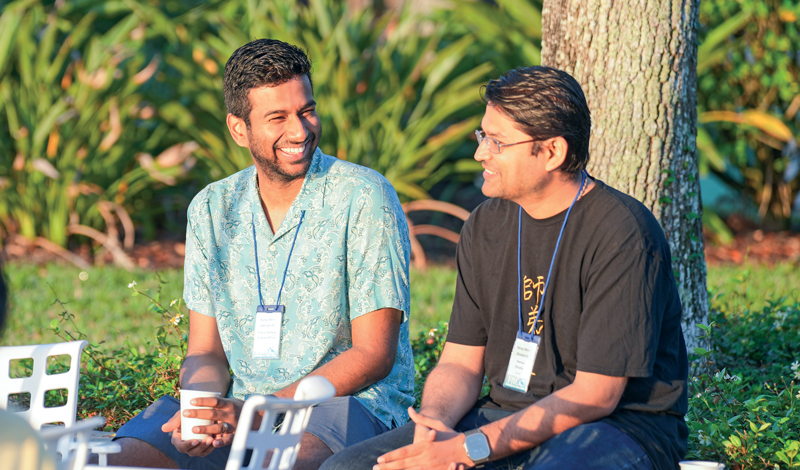Members:
• should be district through national youth leaders.
• have their own copy of The Wisdom of the Lotus Sutra, vol. 3.
• should read the assigned material prior to each meeting.
Syllabus:
The Wisdom of the Lotus Sutra, vol. 3, pp. 167–91
Part Four: “Peaceful Practices” Chapter
• The Lotus Sutra Enables All People To Attain Absolute Peace and Happiness
Supplementary Materials:
• The Lotus Sutra and Its Opening and Closing Sutras, pp. 235–51
• The Record of the Orally Transmitted Teachings, pp. 115–17
Chapter Overview
The Four Peaceful Practices
“Peaceful Practices,” the 14th chapter of the Lotus Sutra, concludes the sutra’s first half, or theoretical teaching. In it, Shakyamuni Buddha specifies various disciplines for bodhisattvas to adhere to as they spread Buddhism. These many detailed points are grouped into four broad practices:
1. peaceful practice of the body, or peaceful action: avoiding temptations and meditating in a quiet place
2. peaceful practice of the mouth, or peaceful speech: teaching the Lotus Sutra without speaking of the faults of other people or scriptures
3. peaceful practices of the mind, or peaceful thought: setting aside jealousy and thoughts of contention when preaching the Lotus Sutra
4. peaceful practice of vows: arousing a mind of great compassion to save all living beings.
Nichiren Daishonin teaches that “the essence of these peaceful practices is this Nam-myoho-renge-kyo” (The Record of the Orally Transmitted Teachings, p. 232).
He also says that in the age in which we live, the Latter Day of the Law: “The four peaceful practices correspond to shoju. To carry them out in this age would be as foolish as sowing seeds in winter and expecting to reap the harvest in spring” (“On Practicing the Buddha’s Teachings,” The Writings of Nichiren Daishonin, vol. 1, p. 394).
Shoju is a way of propagating Buddhism in which one gradually leads people to the Mystic Law without refuting their attachments to other teachings. In sharing Buddhism in this present day, we engage in the practice of shakubuku, of helping people uproot erroneous views and leading them to the correct Buddhist teaching.
Ikeda Sensei says that “all our efforts to explain Buddhism with a sincere and earnest desire to help others become happy are shakubuku” (The Wisdom of the Lotus Sutra, vol. 3, p. 173). He continues:
If “Peaceful Practices” is a discourse on method, then the immediately preceding “Encouraging Devotion” chapter is an explanation of spirit; namely, the spirit of not begrudging one’s life. It is the spirit to prize the Law more highly even than one’s life. Unless we interpret “Peaceful Practices” based on this spirit, we may be left with the impression that all we need to consider is the shallow question of “How can I carry out a peaceful practice?”
“Peaceful,” in “four peaceful ways of practice,” fundamentally means practicing the Mystic Law in thought, word and deed—the three categories of action—that is to say, with one’s entire being. By carrying out such a practice, one’s life becomes saturated with peace and happiness. Nam-myoho-renge-kyo is the Law of true peace and happiness. (WLS-3, 176)
When we “saturate” our lives with Nam-myoho-renge-kyo and share Buddhism with others, Sensei says, “we can establish a state of life of such composure that we can even regard the obstacles we encounter as causes for a peaceful life” (WLS-3, 167).
—Prepared by the SGI-USA Study Department
Buddhist Parable
The Priceless Gem in the Topknot
The Lotus Sutra’s “Peaceful Practices” chapter includes one of its seven parables, the Priceless Gem in the Topknot. This parable is about a wheel-turning king who, after a battle, rewards his soldiers with various treasures. But there is one treasure he doesn’t give away easily: a bright jewel hidden in his topknot. He bestows this precious gem to a highly distinguished soldier.
In conveying this parable, Shakyamuni compares the Lotus Sutra to the gem in the topknot, while the various other treasures represent provisional teachings. And like the wheel-turning king offering the gem from his topknot, Shakyamuni says he will finally reveal his foremost teaching of the Lotus Sutra.
“Through the long night,” he says, “I have guarded and protected it and have never recklessly propagated it. But today for the first time I expound it for your sake” (The Lotus Sutra and Its Opening and Closing Sutras, p. 247).
—Prepared by the SGI-USA Study Department
Wisdom Into Action
Diving Into Study

Sunil Kumar Bandaru
Davis, Calif.
Q: How has it been for you to participate in the Ikeda Wisdom Academy?
I’ve attended a few Ikeda Wisdom Academy meetings since recently being appointed a youth leader. Studying Buddhism has always been the weaker of my three pillars of faith, so I enthusiastically started attending academy meetings.
It was apparent from the first meeting that the academy is much more than a study group. I enjoy the heartfelt discussions between participants after the video presentation. I feel the genuine camaraderie among the youth and see how studying helps us profoundly understand one another’s hearts.
One of my takeaways from a recent academy meeting was the oneness of good and evil. At the time, I was struggling with a personal relationship and had developed negative feelings toward that person. The study was about how Shakyamuni Buddha referred to Devadatta as a “good friend” even after being betrayed by him.
Ikeda Sensei explains that if evil functions to reveal good, then evil in its entirety becomes good. This perspective helped me develop compassion toward this person. We had a dialogue where I put forward kindness instead of judgment. Although the root cause of the conflict remained, I made the best of the relationship. Studying this gave me hope, and I could see proof of the oneness of good and evil and how we can transform evil functions into the impetus to reveal good.
I am challenging to improve my understanding of Buddhism so that I can answer any question that people may have through the Buddhist lens.
LOOKING FORWARD: September Syllabus
The Wisdom of the Lotus Sutra, vol. 3, pp. 195–247
Part Four: “Emerging from the Earth” Chapter
• “Upsetting Attachments and Arousing Doubts”: Inducing a Revolutionary Leap in Consciousness
• A Cultural History of the Lotus Flower
You are reading {{ meterCount }} of {{ meterMax }} free premium articles

